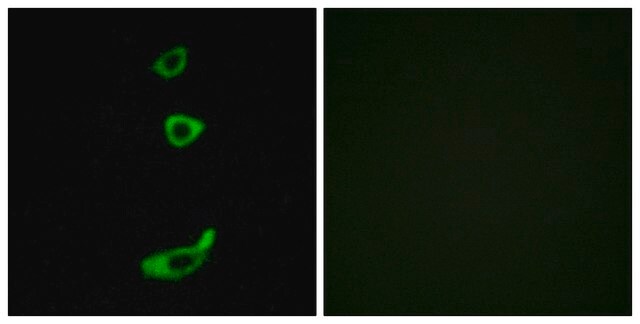詳細
We are committed to bringing you greener alternative products, which adhere to one or more of The 12 Principles of Green Chemistry. This antibody is Preservative-free, produced without the harm or sacrifice of animals and exceptionally stable to allow for ambient shipping and storage if needed and thus aligns with "Waste Prevention", "Designing Safer Chemicals" and "Design for Energy Efficiency".
Click here for more information.
ZooMAb® antibodies represent an entirely new generation of recombinant monoclonal antibodies. Each ZooMAb® antibody is manufactured using our proprietary recombinant expression system, purified to homogeneity, and precisely dispensed to produce robust and highly reproducible lot-to-lot consistency. Only top-performing clones are released for use by researchers. Each antibody is validated for high specificity and affinity across multiple applications, including its most commonly used application. ZooMAb® antibodies are reliably available and ready to ship when you need them.
特異性
Clone 1N21 is a ZooMAb® rabbit recombinant monoclonal antibody that specifically detects Corticotropin-releasing factor receptor 1 (CRFR1). It targets an epitope within 15 amino acids from the first extracellular domain within the N-terminal half.
免疫原
KLH-conjugated linear peptide corresponding to 15 amino acids from the first extracellular domain within the N-terminal half of human Corticotropin-releasing factor receptor 1 (CRFR1).
アプリケーション
Quality Control Testing
Evaluated by Western Blotting in PC12 cell lysate.
Western Blotting Analysis: A 1:10,000 dilution of this antibody detected CRFR1/CRHR1 in PC12 cell lysate.
Tested Applications
Western Blotting Analysis: A 1:1,000 dilution from a representative lot detected CRFR1/CRHR1 in Human brain and Human pituitary tissue lysates.
Immunocytochemistry Analysis: A 1:100 dilution from a representative lot detected CRFR1/CRHR1 in Neuro2A cells.
Affinity Binding Assay: A representative lot of this antibody bound CRFR1/CRHR1 peptide with a KD of 2.9 x 10-6 in an affinity binding assay.
Note: Actual optimal working dilutions must be determined by end user as specimens, and experimental conditions may vary with the end user.
ターゲットの説明
Corticotropin-releasing factor receptor 1 (UniProt: P34998; also known as CRF-R-1, CRF-R1, CRFR-1, Corticotropin-releasing hormone receptor 1, CRH-R-1, CRH-R1) is encoded by the CRHR1 (also known as CRFR, CRFR1, CRHR) gene (Gene ID: 1394) in human. CRFR1, a member of the G-protein coupled receptor 2 family, is a multi-pass, heterodimeric, membrane glycoprotein, which is synthesized with a signal peptide (aa 1-23) that is subsequently cleaved off to produce the mature protein that contains seven transmembrane domains. It is predominantly expressed in the cerebellum, pituitary, cerebral cortex, and olfactory lobes. It can heterodimerize with G protein-coupled estrogen receptor 1 (GPER1). CRFR1 is reported to bind neuropeptides of the corticotropin releasing hormone family that are major regulators of the hypothalamic-pituitary-adrenal pathway and plays an important role in orchestrating neuroendocrine, behavioral, and autonomic responses to stress. It displays high affinity for corticotropin-releasing factor(CRH) and urocortin (UCN). Ligand binding is shown to result in a conformation change, which triggers signaling via G proteins and down-stream effectors, such as adenylate cyclase. CRFR1 is also required for normal embryonic development of the adrenal gland and for normal hormonal responses to stress. Phosphorylation of serine 301 that is located in the third intracellular loop is shown to be critical for its efficient coupling to G proteins and to second messenger generation. Its phosphorylation at serine 330 by protein kinase A (PKA) prevents maximal coupling to Gq-protein, and thereby negatively regulates its downstream signaling. Five isoforms of CRH-R1 have been described that are produced by alternative splicing. This ZooMAb® recombinant monoclonal antibody, generated by our propriety technology, offers significantly enhanced specificity, affinity, reproducibility, and stability over conventional monoclonals. (Ref.: Bender, J., et al. (2015). PLoS ONE 10(9): e0136768; Pioszak, AA., et al. (2008). J. Biol. Chem. 283(47); 32900-32912; Papadopoulou, N., et al. (2004). Mol. Endocrinol. 18(3); 624-639).
物理的形状
Purified recombinant rabbit monoclonal antibody IgG, lyophilized in PBS with 5% Trehalose, normal appearance a coarse or translucent resin. The PBS/trehalose components in the ZooMAb formulation can have the appearance of a semi-solid (bead like gel) after lyophilization. This is a normal phenomenon. Please follow the recommended reconstitution procedure in the data sheet to dissolve the semi-solid, bead-like, gel-appearing material. The resulting antibody solution is completely stable and functional as proven by full functional testing. Contains no biocide or preservatives, such as azide, or any animal by-products. Larger pack sizes provided as multiples of 25 µL.
再構成
300 µg/mL after reconstitution at 25 µL per vial. Please refer to guidance on suggested starting dilutions and/or titers per application and sample type.
保管および安定性
Recommend storage of lyophilized product at 2-8°C; Before reconstitution, micro-centrifuge vials briefly to spin down material to bottom of the vial; Reconstitute each vial by adding 25 µL of filtered lab grade water or PBS; Reconstituted antibodies can be stored at 2-8°C, or -20°C for long term storage. Avoid repeated freeze-thaws.
法的情報
ZooMAb is a registered trademark of Merck KGaA, Darmstadt, Germany
免責事項
Unless otherwise stated in our catalog or other company documentation accompanying the product(s), our products are intended for research use only and are not to be used for any other purpose, which includes but is not limited to, unauthorized commercial uses, in vitro diagnostic uses, ex vivo or in vivo therapeutic uses or any type of consumption or application to humans or animals.






